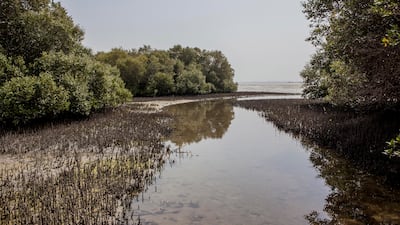The UAE’s coastal lagoons generate tens of millions of dirhams a year, highlighting the economic benefits of protecting marine habitats, a study has found.
Released by organisations including Emirates Nature – WWF, the research showed Umm Al Quwain's Khor Al Beidah, which is a haven for threatened species, and Abu Dhabi's Khor Faridah generate on average $22.75 million (Dh 83.56 million) each year, with about 17,800 people visiting both lagoons.
International Union for Conservation of Nature president
“The coastal lagoon study demonstrates that benefits of these integral habitats extend beyond climate and biodiversity, presenting opportunities to safeguard existing industries such as our vital fisheries while catalysing innovation in growing areas such as eco-tourism, local food production and sustainable agriculture,” Dr Amna Al Shamsi, Minister of Climate Change and Environment, said.
Published by the “Nature-based Solutions (NbS) for Climate, Biodiversity and People” project, the study also called for coastal lagoons – described as “the nation’s greatest and most diverse natural capital” and covering 27 per cent of the UAE’s coastline – to be protected and sustainably managed.
Razan Al Mubarak, president of the International Union for Conservation of Nature, emphasised that more funding was needed to introduce nature-based solutions at a large scale, describing nature as “a powerful ally against climate change”.
She said the coastal lagoon study demonstrated to non-state organisations, including those in the private sector, “the economic benefits of protecting and restoring our coasts and marine habitats”.
“I call upon businesses and financing institutions to carefully consider these opportunities and integrate nature-based solutions into their long-term decision-making.”

When surveyed for the study, sixty-five per cent of residents and tourists said lagoons should be protected and they would pay around Dh40.80 ($11) to visit them.
With potential economic benefits in sight, Sheikh Majid Al Mualla, Chairman of Umm Al Quwain’s Department of Tourism and Archaeology and the High Committee for the Sustainable Blue Economy Strategy, said the emirate aimed to have a “nature-positive tourism model” as part of its “Sustainable Blue Economy Strategy 2031".
The study, Coastal lagoons: essential ecosystems to scale up Nature-based Solutions in the UAE, also found that several of the species that find a haven in the UAE’s lagoons are classified as endangered or critically endangered on the IUCN’s Red List, a database that assesses whether organisms are threatened.
These include whip rays, blacktip reef sharks, the giant guitarfish and halavi guitarfish. The guitarfish is only found in the Arabian Sea.
“Several of these lagoons have also been identified as important bird and biodiversity areas for numerous IUCN Red List species, including the resident Socotra cormorants and greater flamingos, as well as migrating waterbirds such as the great knot and greater sand plover,” the report said.
Officials behind the project added these habitats can protect against threats such as coastal erosion and inundation, and reduce the effects of climate change by storing “blue carbon”.
The study states that mangroves, seagrasses and salt marshes can store twice as much carbon as land forests. Over their 160-square-kilometre area, Khor Al Beidah and Khor Faridah store about 900,000 tonnes of carbon in living biomass and in the top 50cm of soil, according to the project.
This is equivalent to the annual carbon dioxide emissions of more than 160,000 UAE residents, and a lack of protection of such habitats risks releasing blue carbon – stored in sea or coastal environments – back into the atmosphere.
Funded by HSBC Middle East, the NbS project is a collaboration between the Ministry of Climate Change and the Environment, the Ministry of Economy, the Environment Agency – Abu Dhabi, the Government of Umm Al Quwain, Emirates Nature – WWF and Dubai’s International Centre for Biosaline Agriculture.
“It's the first of its kind to investigate the natural capital across the UAE’s top priority sites for credible nature-based solutions,” said Laila Mostafa Abdullatif, director general of Emirates Nature – WWF.
The project aims to develop additional eco-tourism and agroecology projects involving the public and private sectors that will support economic growth.









